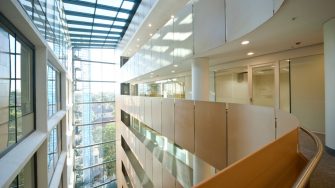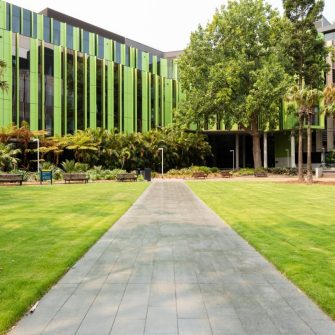
The working environment should be maintained so that it remains in a clean and safe condition.
To ensure the safety of the working environment:
- report any broken fittings or furniture
- ensure emergency exits remain clear at all times
- spills on floors should be cleaned up immediately
- walkways should be kept clear of obstructions
- work materials should be neatly stored
- any waste should be regularly removed.
-
Sufficient lighting must be provided, whether it is from a natural or artificial source, to allow safe movement around the workplace and to allow workers to perform their job without having to adopt awkward postures or strain their eyes to see.
Table 1: Recommended illumination levels (AS/NZS 1680.1: 2006 – Interior workplace lighting)
Class of task Recommended illuminance (lux) Characteristics of the activity/interior Examples of types of activities/interiors Movement and orientation 40 For little-used interiors with visual tasks limited to moving around. Corridors; cable tunnels; indoor storage tanks; walkways. Rough intermittent 80 For interiors used intermittently, with visual tasks limited to movement, orientation and coarse detail. Workers change and locker rooms; live storage of bulky materials; dead storage of materials needing care; loading bays. Simple 160 Continuously occupied interior with visual tasks (coarse detail only.) Occasional reading of clearly printed documents for short periods. Waiting rooms; entrance halls; canteens; rough checking of stock; rough bench and machine work; general fabrication of structural steel; casting concrete; automated process monitoring; turbine halls. Ordinary or moderately easy 240 Continuously occupied interiors with moderately easy visual tasks with high contrasts or large detail. School boards and charts; medium woodworking; food preparation; counters for transactions; computer use. Moderately difficult 320-400 Areas where visual tasks are moderately difficult with moderate detail or with low contrasts. Routine office tasks (e.g. reading, writing, typing, enquiry desks.)
Inspection of medium work; fine woodwork; enquiry points; car assembly.
Difficult 600 Areas where visual tasks are difficult with small detail or with low contrast. Drawing boards; most inspection tasks; proofreading; fine machine work; fine painting and finishing; colour matching. Very difficult 800 Areas where visual tasks are very difficult with very small detail or with very low contrast. Fine inspection; plant retouching; fine manufacture; grading of dark materials; colour matching of dyes. -
Noise is often described as any disturbing sound. Sources of noise may include:
- office equipment (eg., telephones, printers, photocopiers)
- people (i.e., conversations)
- background noise (eg., lifts, air conditioning, traffic).
Most noise levels in the office areas are below levels known to result in risk to hearing, however, they can be distracting to concentration and / or affect communication.
Hints for controlling office noise
- Isolate noisy equipment such as printers or photocopiers by positioning them in separate rooms, or by fitting screens.
- Use sound absorbing materials for internal walls and partitions, window glazing if external traffic.
- Select equipment with lowest noise specifications.
- Lower the ring volume setting on a telephones.
- Establish local area guidelines ie. areas to have conversations.
- The Health and Safety Unit can perform noise measurement assessments.
-
Work should be carried out in an environment where a temperature range is comfortable for workers and suits the work they carry out. Air temperatures that are too high or too low can contribute to fatigue and heat or cold related illnesses. Thermal comfort is affected by many factors, including air temperature, air movement, floor temperature, humidity, clothing, the amount of physical exertion, average temperature of the surroundings and sun penetration.
Optimum comfort for sedentary work is between 20 and 26 degrees Celsius, depending on the time of year and clothing worn. Workers involved in physical exertion usually prefer a lower temperature range. The means of maintaining a comfortable temperature will depend on the working environment and the weather, and could include any of the following:
- air-conditioning
- fans
- electric heating
- open windows
- building insulation
- the layout of workstations
- direct sunlight control
- controlling air flow and the source of drafts.
-
Workplaces should be adequately ventilated. Fresh, clean air should be drawn from outside the workplace, uncontaminated by discharge from flues or other outlets, and be circulated through the workplace.
Workplaces inside buildings may have natural ventilation, mechanical ventilation (fans or extraction units) or air-conditioning. An air-conditioning system should:
- provide a comfortable environment in relation to air temperature, humidity and air movement
- prevent the excessive accumulation of odours
- reduce the levels of respiratory by-products, especially carbon dioxide, and other indoor contaminants that may arise from work activities
- supply an amount of fresh air to the workplace, exhaust some of the stale air as well as filter and recirculate some of the indoor air.
Natural ventilation should consist of permanent openings, including windows and doors, that:
- in total are the size of at least five per cent of the floor area of the room
- are open to the sky, an open covered area or an appropriately ventilated adjoining room.
Natural ventilation may be assisted by mechanical ventilation.
Enclosed workplaces should be supplied with comfortable rates of air movement (usually between 0.1 m and 0.2 m per second).



